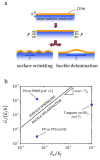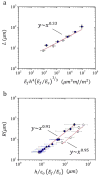Wrinkling-to-delamination transition in thin polymer films on compliant substrates
- PMID: 29034929
- PMCID: PMC5832036
- DOI: 10.1039/c7sm01472d
Wrinkling-to-delamination transition in thin polymer films on compliant substrates
Abstract
Compressing a thin, stiff film attached to a thick, compliant substrate can lead to a number of different modes of mechanical deformation depending upon the material properties of the system. In this article we explore direct transitions from surface wrinkling to buckle delamination, and provide a theoretical framework for understanding the conditions under which such transitions take place, as well as the resulting dimensions of the wrinkling-induced delamination. A key conclusion of this work is that the width of the delamination blister formed from a wrinkled film is relatively strain-independent, suggesting that delaminations can be used in such systems to measure the adhesion energy at the film-substrate interface. In addition, we demonstrate how the length and width of delaminations can be tailored through straightforward control of the substrate and film properties in the system, illustrating how wrinkling delaminations can be used for both thin film metrology and patterning applications.
Conflict of interest statement
There are no conflicts to declare.
Figures





References
-
- Bowden N, Brittain S, Evans AG, Hutchinson JW, Whitesides GM. Nature. 1998;393:146–149.
-
- Chung JY, Nolte AJ, Stafford CM. Adv Mater. 2009;21:1358–1362.
-
- Stafford CM, Harrison C, Beers KL, Karim A, Amis EJ, VanLandingham MR, Kim HCC, Volksen W, Miller RD, Simonyi EE. Nat Mater. 2004;3:545–550. - PubMed
-
- Xiao J, Jiang H, Khang DY, Wu J, Huang Y, Rogers JA. J Appl Phys. 2008;104:33543–7.
-
- Gunawidjaja R, Ko H, Jiang C, Tsukruk VV. Chem Mater. 2007;19:2007–2015.
Grants and funding
LinkOut - more resources
Full Text Sources
Other Literature Sources

